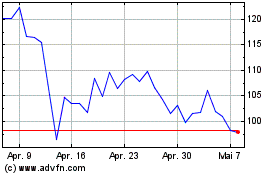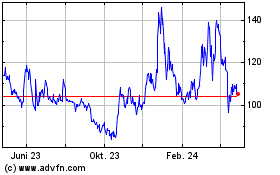Arthur Hayes Reveals How To Trade Crypto Amid The ‘Dollar-Yen Death March’
07 August 2024 - 7:00PM
NEWSBTC
In his latest essay “Spirited Away,” Arthur Hayes, the former CEO
of BitMEX, dives into the complexities of the global financial
markets, with a focus on the impending unwinding of the dollar-yen
carry trade and its impact on the crypto market. Hayes begins by
discussing the potential actions of the US Vice President Kamala
Harris in response to an impending financial crisis, influenced by
her need to secure electoral victory. He predicts, “Harris will
instruct Yellen to use the monetary tools available to her to avert
a financial crisis,” suggesting an immediate response to stabilize
the markets expected “no later than the opening of Asian trading
next Monday, August 12th.” Related Reading: Bitwise CIO Believes
The Crypto Crash Sets The Stage For Bitcoin To Thrive – Key Reasons
Why The analysis revolves around the ‘yen carry trade,’ where Japan
Inc. borrows yen at low rates to invest in higher-yielding foreign
assets. This trade has been massively profitable due to the Bank of
Japan’s (BOJ) policies that keep yen liabilities low and asset
returns high, facilitated by a weak yen. However, Hayes points out
the vulnerabilities of this strategy: “If the BOJ ceases its bond
purchases, the unwinding could lead to significant yen appreciation
and a corresponding decline in global equity markets.” Hayes
outlines the potential dire consequences of a sudden strengthening
of the yen, predicting drastic impacts on global stock markets. He
quantifies these impacts, stating, “If the dollar-yen reached 100,
a 38% move, the Nasdaq would drop to ~12,600 and the Nikkei to
~25,365,” indicating severe repercussions for global financial
stability. According to the former BitMEX CEO, the full unwind of
the dollar-yen carry trade is a question of when, not if. “The
question is when the Fed and Treasury will print money to blunt its
effects on Pax Americana,” he adds and describes a scenario where
the US equity markets could crash into this upcoming Friday. “Then
some sort of action over the weekend is probable,” according to
Hayes. He further theorizes on a more long-term scenario: “If the
yen starts to weaken again, the crisis is over in the immediate
term. The unwind will continue, albeit at a slower pace. I believe
the markets will throw another tantrum between September and
November as the dollar-yen pair resumes its death march toward 100.
There will definitely be a response this time around, as the US
presidential election will be weeks or days away.” How To Trade
Crypto In This Environment Hayes describes the situation as complex
due to two conflicting liquidity forces. “Trading this in a crypto
fashion is difficult. Two opposing forces influence my crypto
positioning,” he states. First, there is the “Liquidity Positive
Force”. This force emerges from the US Treasury’s potential
actions, which could inject significant dollar liquidity into the
market. Hayes notes, “After a quarter of net restrictive policy,
the US Treasury will net inject dollar liquidity because it will
issue Treasury bills and possibly deplete the Treasury General
Account.” This influx of liquidity could buoy markets, including
cryptocurrencies, by providing more capital for investment. Related
Reading: Why The 4-Year Crypto Cycle Is A Thing Of The Past:
Top-Analyst Conversely, the strengthening of the yen (“Liquidity
Negative Force”), driven by the unwinding of the carry trade, would
necessitate a global sell-off of financial assets as higher yen
costs make debt servicing more expensive. This force could lead to
a withdrawal of liquidity from markets, exerting downward pressure
on asset prices, including cryptocurrencies. Hayes proposes that
the interplay of these forces will dictate the behavior of Bitcoin
and other cryptocurrencies. He categorizes potential outcomes into
two scenarios: Convex-Bitcoin Scenario: In this scenario, Bitcoin
could rise in value regardless of whether the dollar-yen pair
strengthens or weakens, indicating that the market expects a
bailout if the yen strengthens and that the liquidity provided by
the US Treasury is sufficient to counteract the negative impacts.
Correlated-Bitcoin Scenario: Here, Bitcoin’s price movements would
align closely with traditional financial markets. A strengthening
yen would lead to a fall in Bitcoin prices, and a weakening yen
would result in a rise, mirroring the liquidity shifts in
traditional finance. “If the setup is convex-Bitcoin, I will
aggressively add positions as we have reached the local bottom. If
the setup is correlated-Bitcoin, then I will sit on the sidelines
and wait for the eventual market capitulation. The mega assumption
is that the BOJ will not reverse course, cut deposit rates back to
0%, and resume unlimited JGB purchases. If the BOJ sticks by the
plan it laid out at its last meeting, the carry trade unwind will
continue,” Hayes concludes. At press time, BTC traded at $57,200.
Featured image from YouTube, chart from TradingView.com
Quant (COIN:QNTUSD)
Historical Stock Chart
Von Dez 2024 bis Jan 2025

Quant (COIN:QNTUSD)
Historical Stock Chart
Von Jan 2024 bis Jan 2025
